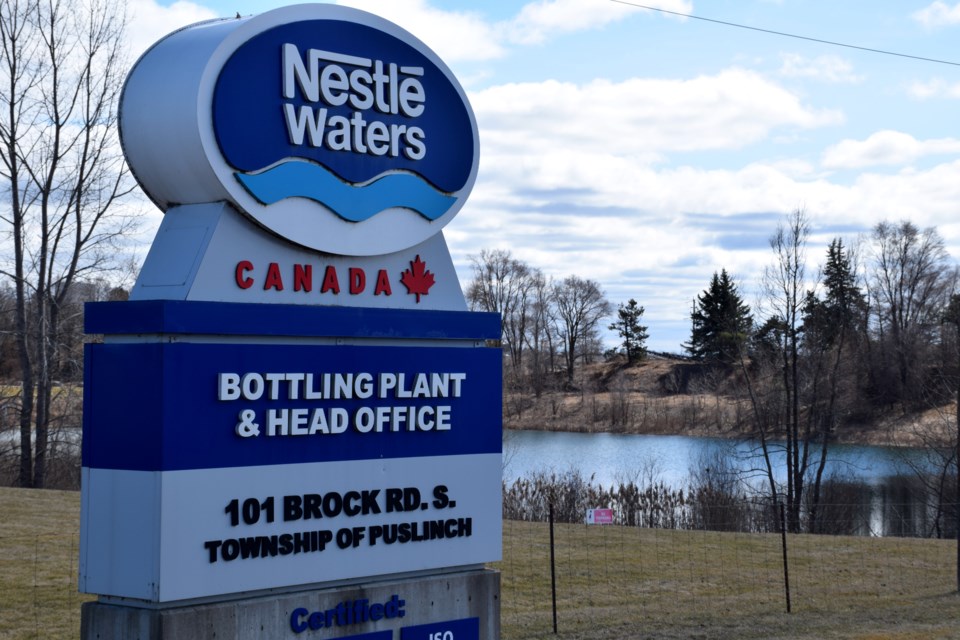There is a lot of emotion surrounding the issue of the water we drink. And there is a lot of science, as well.
Nestlé Waters Canada, the country’s largest bottled water manufacturer and distributor, is eager to accentuate the science behind its water-taking operation in the Guelph area. It is preparing a report on the water monitoring science it carries out, part of its permit renewal process. That report is expected to be ready next week.
The company hosted a stakeholders presentation Tuesday morning, and a media briefing Tuesday afternoon at the Puslinch Community Centre, just up the road from the company’s Aberfoyle bottling plant. GuelphToday.com was the sole media outlet to accept the company’s afternoon invitation.
Company officials sat quietly in the background as third-party scientists went over some key scientific findings related to Nestlé’s two wells in Wellington County.
Christopher Neville, senior hydrologist with the environmental and water-source consultant firm S.S. Papadopulos and Associates of Waterloo, conducted the media briefing. Beacon Environmental ecologist Rob Aitken and Golder Associates hydrogeologist Greg Padusenko were also on hand to answer questions.
Nestlé has just two active wells in the county, one near its Aberfoyle plant, the other in Hillsburgh, just outside of Erin. Water from Hillsburgh is trucked to Aberfoyle.
The Aberfoyle well penetrates down to what is commonly called the “Amabel” aquifer, while Hillsburgh taps the shallower “Guelph” aquifer, which sits above “Amabel.”
Using a water-level monitoring graphic, Neville showed that annual water-taking from the wells sits at an average of about 60 per cent of what the company is allowed to draw from the aquifers.
That data shows that pumping levels fluctuate annually, and even daily, depending on demand for bottled water. Since the 2008 financial crisis, demand has been lower than pre-2008 levels. But the demand has been inching back up in recent years.
Neville said it is important to understand that pumping groundwater for bottling purposes is not like mining a pool of water. It is more a process of intercepting a portion of what would otherwise be discharged at a point further down the system.
Nestlé, he said, is in the water business “for the long-haul,” and the company only takes water at sustainable levels. “Science and data drives decision-making, and ensures the quality and quantity of the source,” he said.
Water levels are constantly monitored, Neville said. There are 82 monitoring points within a 1.8 kilometer radius of the Aberfoyle well. But there is also consistent monitoring of “bugs and bunnies” – the counting of all types of species of flora and fauna, from turtles and owls, to grass and trees.
Such monitoring is mandatory at Aberfoyle, and voluntary at Hillsburgh. The company carries it out at both sites to determine if there are any long-term changes to the biological communities present near the water source. Consistently since 2007, those ecosystems have consisted of 90 per cent native species. Changes in non-native species prevalence is an indication of an ecosystem under stress, Neville said.
“Ecological communities have remained stable over time,” he said.
Rob Aitken was asked if there was cause for concern related to any invasive species. He said the common reed, a large, invasive tall grass, is very aggressive and adept at spreading. Nestlé has carried out some cutting and tarping to control the grass, but will not utilize pesticides to control it.
Neville was asked about the impacts of drought on the water quantities in the aquifers. He said aquifers are generally “insensitive to levels of prescription,” with only negligible impacts. Nevertheless, Nestlé voluntarily reduces its pumping levels during periods of drought, based on recommended reduction levels outlined by the Grand River Conservation Authority (GRCA).
Jennifer Kerr, Nestlé Waters Canada director, corporate affairs, said a number of stakeholders took part in the morning session, including the Ministry of the Environment, GRCA, University of Guelph and University of Waterloo, Wellington Water Watchers, and Environmental Defence.
The science, said Neville, shows there are “no negative impacts to the long-term sustainability of the aquifer or ecosystem.”
